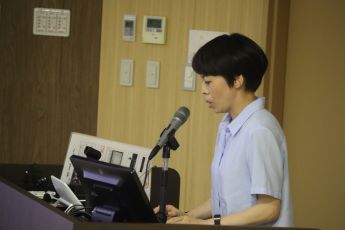- Home
- Student Activity
- Student Monthly Progress #14
The 14th Student Monthly Progress was held on July 26th, 2024.
Four students introduced their research.
【Presenters】
1. MULENGA Nomsa Handondo:Laboratory of Veterinary Surgery
<Role of Nerve Growth factor and anti-Nerve Growth Factor Monoclonal Antibodies in Osteoarthritis pathophysiology.>
2. WATABNABE Kanami:Laboratory of Toxicology
<Toxicology Evaluation of Heavy Metal and Pesticide Presence in Fecal Samples from African Savanna Elephants Lower Zambezi National Park, Zambia>
3. MAEDA Aiko:Laboratory of Veterinary Hygiene
<Analysis of possible transmission mechanism of fluoroquinolone-resistant Escherichia coli ST131 in the community>
4. DARAWIROJ Kanittha:Laboratory of Veterinary Surgery
<Effect of Fuzapladib Sodium Hydrate on expression of adhesion molecule in canine endothelial cell>
【Chair】
BANDA Nelly:Laboratory of Toxicology
HEW Yik Lim:Laboratory of Microbiology

❖Chairperson’s Report❖
Role of Nerve Growth factor and anti-Nerve Growth Factor Monoclonal Antibodies in Osteoarthritis pathophysiology.
MULENGA Nomsa Handondo

Osteoarthritis (OA) remains a worldwide health problem, with the primary course oftreatment being pain management with Non-Steroidal Anti-inflammatory drugs. However, due to their long-term use effects and their role in Rapidly Progressive Osteoarthritis (RPOA)warrants the need for use of alternative drugs and therapies. Nomsa’s research focus on one of those alternatives, which is Nerve Growth Factor (NGF). NGF increases in cases of chronic pain, after injury and following inflammation. In veterinary medicine, Anti-NGF monoclonal antibodies are used to treat OA. Her study aims at investigating the role of NGF and anti-NGF on canine chondrocytes and determine the mechanisms of anti- NGF treatment on RPOA. Thus far, the study has revealed that treatment with anti-NGF resulted in high matrix mineralisation. When cell culture groups were subjected to Interleukin -1 beta, anti-NGF downregulated SOX-9 levels. Further experimentation is required to confirm the current findings of how NGF may be necessary in the regulation of chondrocyte hypertrophy.
Toxicology Evaluation of Heavy Metal and Pesticide Presence in Fecal Samples from African Savanna Elephants Lower Zambezi National Park,
Zambia
WATANABE Kanami

Among the common anthropogenic related pollutants are heavy metals and pesticides. Human activities extend to conservation areas such as national parks. Elephants due to their extensive migration patterns and dietary preferences are susceptible to bioaccumulating pollutants. The main aim of Kanami’s study is to explore the presence and concentrations of heavy metals and pesticides in elephant faeces. This is a non-invasive means of monitoring the health of these endangered species. Faecal samples were collected in two consecutive years (2022 and 2023). Significance variations were noted with regards to Selenium, Cobalt and Nickel. Higher concentrations were recorded in 2023 due to the increase in anthropogenic activities in the area sampled. Trace amounts of pesticides were recorded from the samples, highlighting the importance of wind drafts in exposure routes. These findings require monitoring to observe how the concentrations change and apply mitigative measures.
Analysis of possible transmission mechanism of fluoroquinolone-resistant Escherichia coli ST131 in the community
MAEDA Aiko

For MAEDA Aiko’s research topic, she introduced the prevalence of fluoroquinolone-resistant Escherichia coli (FQREC) ST131 detected in healthy individuals and companion animals in Sapporo from 2021 to 2023. ST131 is an internationally high-risk clone causing urinary tract infections and other diseases in humans, and the isolation of ST131 from human clinical settings, healthy individuals, and companion animals indicated the possibility of transmission within the community. The isolation of ST131 was conducted using CHROMagar ECC and ciprofloxacin containing CHROMagar ECC. The classification of the clade of ST131 identification was done using MLST and multiplex PCR, and the accessory genome of ST131 was used to analyze the similarity of the genetics. The results revealed that ST131 isolated from the companion animal was homology to ST131 in clade C1 derived from humans and sewage, together with the support of the accessory genome analysis. This suggests the occurrence of the transmission of ST131 between humans and their companion pets.
Effect of Fuzapladib Sodium Hydrate on expression of adhesion molecule in canine endothelial cell
DARAWIROJ Kanittha

Lastly, DARAWIROJ Kanittha’s research aimed to study the role of Fuzapladib Sodium Hydrate, which influences the expression of adhesion molecules in canine endothelial cells. The recruitment of neutrophils depends on endothelial adhesion molecules such as ICAM-1, P-selectin, and E-selectin. Thus, Fuzapladib sodium hydrolate is used to understand the potential mechanism that influences the expression of adhesion molecules in endothelial cells. Using an in vitro model with primary canine aortic endothelial cells (CaAEOC), CaAEOC was incubated with either cytokines alone or fuzapladib at various dosages. The impact of fuzapladib on the gene expression of candidate adhesion molecules was investigated. The results demonstrate that fuzapladib does not significantly affect down-regulating E-selectin and ICAM-1. However, fuzapladib significantly downregulated P-selectin gene expression in a dose-dependent manner, which indicates that Fuzapladib may regulate P-selectin gene expression. The impact of fuzapladib on P-selectin protein levels needs further identification.
